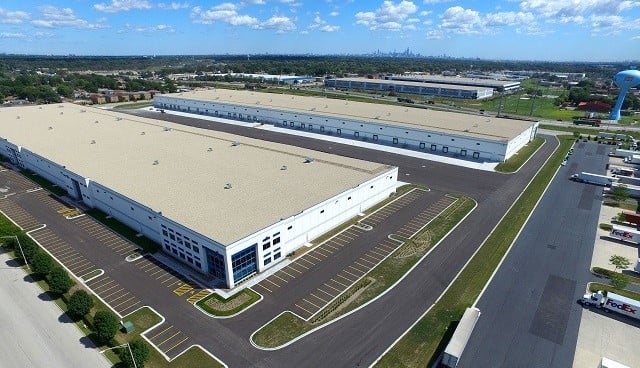
CHICAGO—Largely driven by the expansion of e-commerce, and the subsequent need to reconfigure the supply chain, the US industrial market has outperformed the overall economy since at least 2011. And as the New Year approaches, most experts don't believe the sector will experience a slowdown, at least in the short-term.
“It's hard for anyone to fully predict economic outcomes at this point,” John Morris, head of Cushman & Wakefield's logistics and industrial services practice in the Americas, tells GlobeSt.com. But whatever uncertainty has arisen due to the election, the demand for new distribution and warehouse space shows every sign of continuing.
C&W typically winds up its meetings with clients hunting for new space in the first few months of the year by Thanksgiving, he says. This year, however, “we had meetings scheduled all the way through Christmas.”
The US industrial sector has registered 26 consecutive quarters of net occupancy gains, according to C&W research. At the end of the third quarter of 2016, vacancy had fallen to just 5.6%, a year-over-year drop of 90 bps, tracking a full 280 bps below the 10-year historical average.
And strong leasing activity by both traditional industrial users and e-commerce-related occupiers continues to fuel rent growth, resulting in a 5.1% climb year-over-year. In fact, industrial rents increased in 66 of 79 markets tracked by C&W from the third quarter of 2015 to the third quarter of 2016, with over 40% of the country reporting double digit gains. In many markets, industrial rents are now at historic highs, and on a national level the US continues to witness rental rate appreciation for every industrial product type.
In any other sector, such numbers would probably mean a loss of energy, but Morris says industrial still has untapped strengths. “So much of this growth is not tied to the economy.” Instead, distributors still need systems that provide last-mile, same-day delivery. And for several years, e-commerce has steadily grown at roughly five times the pace of traditional retail, fueling the demand for even more facilities that can move products to consumers.
There are other factors that have helped boost the overall growth of industrial real estate. Morris says depressed oil prices, for example, have encouraged more shipping. Furthermore, urbanization has brought millions of consumers into new areas, all of which then need new distribution facilities. But without the demand created by e-commerce, the industrial sector would probably have closely tracked, rather than outpaced, the nation's slow but steady economic growth.
Morris does believe the sector will hit a rougher patch in the medium term, but detecting it beforehand will be tough. There are, however, a few factors to watch. Recent census data show, for example, that the urbanization trend may be slowing. But a possible plus for the industrial sector is the potential for even more companies to begin distributing their own products to consumers without a middleman.
And due to the ascension of Donald Trump to the presidency, there has been a lot of chatter about trade wars. That is a important consideration for anyone involved in the market for industrial real estate, Morris says, as imported products help fill the nation's distribution and warehouse facilities. Any move which restricts imports “is going to have a dampening effect on growth.”

CHICAGO—Largely driven by the expansion of e-commerce, and the subsequent need to reconfigure the supply chain, the US industrial market has outperformed the overall economy since at least 2011. And as the New Year approaches, most experts don't believe the sector will experience a slowdown, at least in the short-term.
“It's hard for anyone to fully predict economic outcomes at this point,” John Morris, head of Cushman & Wakefield's logistics and industrial services practice in the Americas, tells GlobeSt.com. But whatever uncertainty has arisen due to the election, the demand for new distribution and warehouse space shows every sign of continuing.
C&W typically winds up its meetings with clients hunting for new space in the first few months of the year by Thanksgiving, he says. This year, however, “we had meetings scheduled all the way through Christmas.”
The US industrial sector has registered 26 consecutive quarters of net occupancy gains, according to C&W research. At the end of the third quarter of 2016, vacancy had fallen to just 5.6%, a year-over-year drop of 90 bps, tracking a full 280 bps below the 10-year historical average.
And strong leasing activity by both traditional industrial users and e-commerce-related occupiers continues to fuel rent growth, resulting in a 5.1% climb year-over-year. In fact, industrial rents increased in 66 of 79 markets tracked by C&W from the third quarter of 2015 to the third quarter of 2016, with over 40% of the country reporting double digit gains. In many markets, industrial rents are now at historic highs, and on a national level the US continues to witness rental rate appreciation for every industrial product type.
In any other sector, such numbers would probably mean a loss of energy, but Morris says industrial still has untapped strengths. “So much of this growth is not tied to the economy.” Instead, distributors still need systems that provide last-mile, same-day delivery. And for several years, e-commerce has steadily grown at roughly five times the pace of traditional retail, fueling the demand for even more facilities that can move products to consumers.
There are other factors that have helped boost the overall growth of industrial real estate. Morris says depressed oil prices, for example, have encouraged more shipping. Furthermore, urbanization has brought millions of consumers into new areas, all of which then need new distribution facilities. But without the demand created by e-commerce, the industrial sector would probably have closely tracked, rather than outpaced, the nation's slow but steady economic growth.
Morris does believe the sector will hit a rougher patch in the medium term, but detecting it beforehand will be tough. There are, however, a few factors to watch. Recent census data show, for example, that the urbanization trend may be slowing. But a possible plus for the industrial sector is the potential for even more companies to begin distributing their own products to consumers without a middleman.
And due to the ascension of Donald Trump to the presidency, there has been a lot of chatter about trade wars. That is a important consideration for anyone involved in the market for industrial real estate, Morris says, as imported products help fill the nation's distribution and warehouse facilities. Any move which restricts imports “is going to have a dampening effect on growth.”
© Touchpoint Markets, All Rights Reserved. Request academic re-use from www.copyright.com. All other uses, submit a request to [email protected]. For more inforrmation visit Asset & Logo Licensing.








